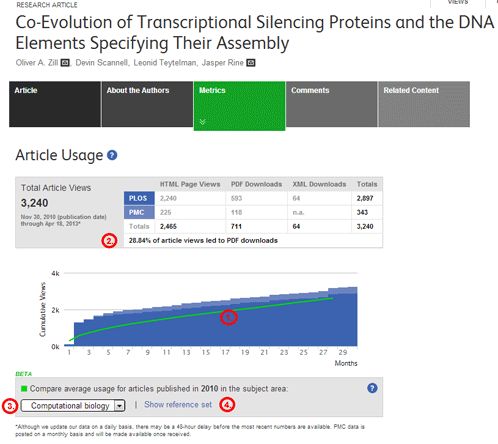Providing context to Article-Level Metrics
In 2009, PLOS was one of the first publishers to place comprehensive performance indicators, called Article-Level Metrics (ALM), on every article leading to a new era in the evaluation of research. Now other publishers have adopted this idea and new businesses have sprung up in this field, further enriching the research impact landscape.
We are pleased to announce the first iteration of Relative Metrics (Beta) to provide much needed context to our existing suite of ALMs. We invite the community to consider how to integrate the additional insight that they provide into their research analysis and assessment.
When you look at the ALM article usage graph, the first thing you will notice is the addition of a green line (1) that helps you to compare average usage for similar articles published in the same time period. We’ve also introduced information on the % of article views that led to PDF downloads (2), an indication of audience engagement and average usage. We will be expanding these indicators, known as descriptive statistics, to cover more ALM’s in the coming months.
 Below the graph, you will find a drop down menu (3) of the different taxonomic classifications assigned to an article which allow you to evaluate relative performance in different fields. You can also review the reference set (4) of the actual articles that are being compared.
Below the graph, you will find a drop down menu (3) of the different taxonomic classifications assigned to an article which allow you to evaluate relative performance in different fields. You can also review the reference set (4) of the actual articles that are being compared.
Please use responsibly! In any rapidly emerging field, the rules of engagement continually change so making sense of the information requires care. This is particularly true when comparing one field with another (where different behavior patterns frequently exist) or between articles that have just been published (interest peaks) with those that have been published for a while (interest may level off) or content that was published many years ago (lower online reading patterns) compared with today (more online reading).
These new ALM features are the first deliverables in a year-long program of Relative Metrics innovations so please look out for further announcements. We welcome your feedback on this new functionality which we will use to help shape future releases.
